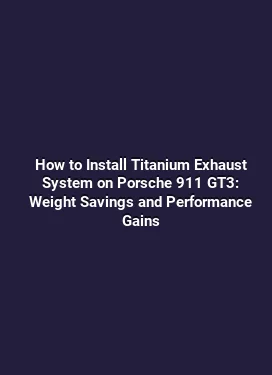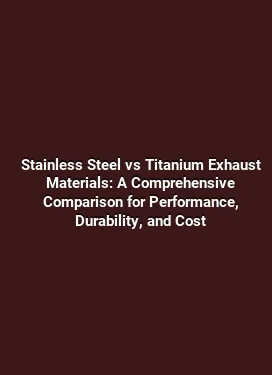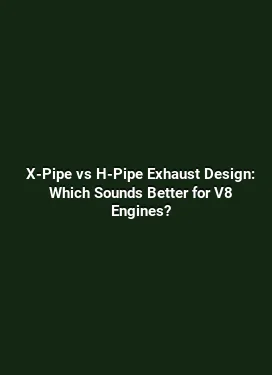Optimal Exhaust Pipe Diameter Calculator for Horsepower and Torque
Understanding the Relationship Between Exhaust Diameter, Flow, and Power

In performance exhaust design, pipe diameter plays a pivotal role in how efficiently exhaust gases exit the combustion chamber. The diameter sets the balance between flow velocity and backpressure, influencing both horsepower and torque curves across RPM ranges. A larger diameter reduces backpressure and can increase peak horsepower, but it may also reduce low-end torque if the system becomes too free-flowing for the engine’s displacement and cam timing. Conversely, a smaller diameter can improve low-end torque and throttle response at the cost of higher exhaust gas velocity and potential restrictions at higher RPM. The art of selecting an optimal diameter lies in aligning exhaust gas dynamics with the engine’s breathing characteristics, cam profile, and intended operating range.
Modern digital calculators for exhaust diameter typically combine principles from fluid dynamics, gas thermodynamics, and practical engine data. They translate engine displacement, exhaust backpressure, and desired RPM windows into actionable pipe sizes, plenum options, and even effective pairings with muffler types. This approach helps enthusiasts and professionals forecast horsepower gains, torque delivery, and sound characteristics without costly trial and error.
Core Principles Behind an Exhaust Diameter Calculator
Effective calculators consider several core factors that determine how diameter affects performance. These elements work together to shape the engine’s flow regime and the resulting power curve.
- Engine breathing: The intake and exhaust port sizing, cam duration, and valve timing determine the volume of exhaust gas that must exit the cylinder each cycle. A diameter that matches the expected gas volume helps maintain an efficient flow path.
- Backpressure vs. scavenging: A well-tuned system minimizes unnecessary backpressure while using designed wave dynamics to promote scavenging, which cleanly evacuates exhaust gases and reduces residual pressure in the cylinder at the end of the exhaust stroke.
- Velocity vs. volume trade-off: Larger diameters increase volume capacity but reduce gas velocity, potentially diminishing the impetus for scavenging at certain RPMs. Smaller diameters boost velocity but may restrict overall flow at high RPMs.
- Resonance and harmonics: The pipe diameter interacts with the exhaust length, creating reflective waves that can either amplify or suppress certain frequency ranges in the engine’s exhaust tone and flow efficiency.
These principles are captured by computational models that predict flow rate, pressure drop, and thermodynamic efficiency. The result is a recommended pipe diameter that aligns with the engine’s torque band, horsepower goals, and the chosen exhaust components (headers, mid-pipes, catalytic converters, and mufflers).
Key Variables for Accurate Diameter Calculation
To ensure a calculator yields credible results, several real-world inputs must be considered. These variables translate into a recommended pipe diameter and a practical build plan.
- Engine displacement and configuration: A larger displacement engine with a broader torque curve may benefit from a slightly larger diameter, while a smaller, high-revving setup might require tighter tolerances for optimal gas velocity.
- Target RPM range: The operating window where horsepower and torque are most important guides the appropriate balance of volume and velocity. Street engines often favor a wide torque peak, while race-tpecific builds may prioritize high-RPM flow.
- Intake and exhaust port characteristics: The port volume, runner length, and valve size influence the volumetric efficiency and gas mass that must exit through the exhaust.
- Header design and arrangement: Shorty headers, long-tube headers, and collector configurations alter pressure pulsations that interact with pipe diameter.
- Ambient conditions: Elevation, ambient temperature, and humidity affect air density and gas properties, subtly shifting the ideal diameter, particularly in high-altitude or hot climates.
- Exhaust system layout: The presence of catalytic converters, mid-pipes, resonators, and mufflers adds additional backpressure and impedance that the diameter must accommodate.
- Sound goals and regulatory constraints: Noise targets can limit the use of certain resonator sizes or muffler designs, indirectly impacting the effective diameter required to meet performance goals.
By incorporating these factors, a robust calculator can produce a recommended diameter that optimizes horsepower and torque without sacrificing drivability or reliability. The outputs should include a primary pipe diameter, alternative sizing for different RPM bands, and notes on how variations in length or component compatibility might shift the results.
Practical example: a 2.5L inline-4 street application

Consider a naturally aspirated 2.5-liter inline-4 with a cam profile tuned for a broad torque band. The goal is to improve mid-range torque for daily driving while preserving top-end horsepower. A practical workflow uses the calculator with the following inputs: displacement, target RPM range (2,500–6,500), current exhaust backpressure measurements, header type, and desired sound character. The calculator suggests a primary diameter of approximately 1.75 inches (about 44.5 mm) for the main run, with a slightly larger secondary section around the collector to accommodate increased flow at higher RPMs. It also indicates how installing a resonator or a specific muffler design can help maintain a bassy, controllable tone without introducing excessive backpressure. The real-world takeaway is that a balanced approach—moderate diameter, complemented by tuned length and muffler characteristics—yields a smooth torque rise and a sustainable power plateau without compromising daily drivability.
Integrating Diameter Calculations with System-Wide Tuning
Exhaust diameter cannot be considered in isolation. Effective performance tuning requires synchronizing diameter with pipe length, header design, and the muffler strategy to achieve a cohesive flow system. A holistic approach considers how the diameter interacts with the entire exhaust path and the engine’s breathing pattern across the operating RPM range.
In practice, this means using the calculator as a starting point to establish a baseline diameter, followed by iterative adjustments guided by dyno feedback or data-logging results. For example, if a dyno run reveals a dip in torque around 3500–4500 RPM, the team may test a slightly larger diameter in that segment or modify primary runner lengths to improve scavenging. Conversely, if peak horsepower is robust but low-end torque is weak, a subtle diameter reduction or a strategic alteration in muffler impedance could rebalance the flow without sacrificing top-end power.
Material, manufacturing tolerances, and real-world constraints
Theoretical diameter outcomes must be tempered by practical considerations. Stainless steel, mandrel-bent tubes, and precise welds influence the actual flow characteristics. Manufacturing tolerances, coating choices, and fitment considerations (off-road vs. street legal setups) affect how closely the built system aligns with the calculator’s recommendations. A high-quality, precision-built exhaust can deliver the predicted benefits more consistently, while poorly matched components may underperform or introduce unwanted resonance that masks the advantages of the optimum diameter.
Trend Keywords and Semantic Links in Exhaust System Design
In the current landscape, tailpipe diameter discussions are enriched by trend-aware terms that reflect evolving material science, acoustic engineering, and performance analytics. Concepts such as flow velocity optimization, backpressure management, scavenging polarity, and resonance tuning appear regularly in engineering discussions and field-tested guides. Semantic connections include ideas like spoke of air impedance, thermal efficiency, and pressure pulsation management, all of which relate to how diameter, length, and component selection shape overall system performance. Incorporating these terms helps frame the topic as part of a comprehensive performance strategy rather than a standalone metric.
Best Practices for Using an Exhaust Diameter Calculator
To maximize value from a diameter calculator, follow these steps that align with real-world workflows used by performance shops and serious hobbyists alike.
- Gather precise engine data: Accurate displacement, bore and stroke, and cam timing settings ensure the calculator’s inputs reflect the engine’s actual breathing characteristics.
- Define operating goals clearly: Decide whether the primary objective is better low-end response, stronger mid-range torque, or higher peak horsepower, and set the RPM windows accordingly.
- Cross-check with components: Match the calculator’s diameter recommendations with the chosen headers, mid-pipes, and muffler options to avoid conflicts in flow impedance.
- Plan for sound and regulatory compliance: Ensure that any diameter choice works with local noise and emission regulations, and consider resonator strategies for a balanced tone.
- Validate with diagnostics: Use flow benches, pressure measurements, and dyno data to verify the predicted gains and refine the diameter as needed.
Common pitfalls and how to avoid them
Several frequent mistakes can undermine the value of a diameter-focused optimization. Overestimating the benefits of a larger diameter without considering the engine’s torque curve can lead to a loss of mid-range power. Inconsistent manufacturing tolerances or poorly matched components can create turbulence and unpredictable flow behavior. Finally, relying on a single data point (such as peak horsepower) without evaluating the entire torque curve can produce a system that feels fast in one regime but is unresponsive in others. A structured approach, backed by data and validated by real-world testing, mitigates these risks.
Advanced Scenarios: When to Consider Multiple Diameter Stages
Some performance builds benefit from staged diameter strategies. This can involve a primary pipe size that optimizes idle and mid-range response, complemented by a larger segment in the mid-pipe or a tuned collector that activates at higher RPMs. Such configurations require careful analysis of exhaust plumbing lengths, pulse timing, and the impedance characteristics of each stage. In race applications, teams may implement variable-diameter headers or adjustable exhaust components to fine-tune the system for specific tracks and conditions. This layered approach can yield a more robust torque curve and a higher usable power band than a single-diameter solution.
Conclusion-Free Zone: How This Knowledge Translates to Real-World Gains
Applying a calculated exhaust pipe diameter is a practical step in refining flow, reducing unwanted pressure, and shaping the engine’s power delivery. By understanding the interplay between diameter, velocity, and backpressure, and by integrating this with header design, mid-pipe architecture, and muffler strategy, enthusiasts can approach performance tuning with a data-driven mindset. The end result is a more predictable and enjoyable driving experience, where torque comes on smoothly and horsepower feels accessible across a broader RPM spectrum. The journey from theory to installation to validation becomes a disciplined workflow, turning abstract concepts into tangible, trackable gains.






